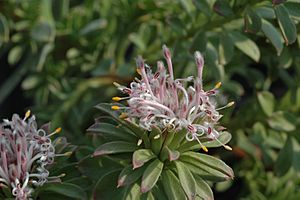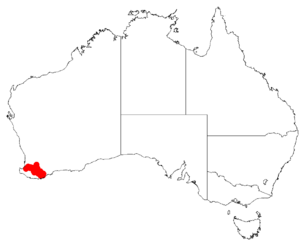Isopogon spathulatus facts for kids
Quick facts for kids Isopogon spathulatus |
|
|---|---|
 |
|
| In the Australian National Botanic Gardens | |
| Scientific classification | |
| Genus: |
Isopogon
|
| Species: |
spathulatus
|
 |
|
| Occurrence data from Australasian Virtual Herbarium | |
| Synonyms | |
|
|
Isopogon spathulatus is a type of flowering plant. It belongs to the Proteaceae family. This plant is special because it is found only in the south-western part of Western Australia. This means it is endemic to that area.
It grows as a shrub. It has leaves that can be long and thin, or shaped like an egg. The flowers are pink and hairy. They grow in round clusters.
Contents
What it Looks Like
Isopogon spathulatus is a shrub. It usually grows to be about 0.7 to 2 meters tall. Its young branches are covered in fine hairs.
The leaves are interesting. They can be long and narrow, or shaped like an egg. The narrower part is at the base. Each leaf is about 10 to 23 millimeters long. They are also about 1.5 to 7 millimeters wide. There is a small point at the end of each leaf.
The flowers grow in round heads. These heads are found at the ends of the branches. They are about 15 to 25 millimeters wide. At the bottom of each flower head are hairy, egg-shaped leaves called bracts.
The flowers themselves are pink and hairy. They are about 14 to 20 millimeters long. You can see these flowers during most months of the year. After the flowers, the plant produces fruit. The fruit is a hairy nut. These nuts are joined together in a round head. This fruit head is about 15 to 20 millimeters wide.
Plant Name and History (Taxonomy)
The scientific name for this plant, Isopogon spathulatus, was first officially described in 1830. A botanist named Robert Brown gave it this name. He wrote about it in his book called Supplementum.
The plant material he used to describe it was collected by William Baxter. He found it near King George's Sound.
Later, in 1870, another botanist named George Bentham thought this plant was just a type of Isopogon buxifolius. But in 2015, two scientists, Hislop and Rye, decided it was its own unique species again. They published their findings in a science journal called Nuytsia.
The second part of the plant's name, spathulatus, has a special meaning. It comes from a word that means "spoon-shaped." This likely describes the shape of its leaves.
Where it Grows (Distribution and Habitat)
This Isopogon plant likes to grow in certain areas. You can find it in heath or shrubland. It prefers places that are swampy or get wet during winter.
It grows in the south-west of Western Australia. Specifically, it is found between the towns of Ruabon and Collie. It also grows near the Stirling Range.
Conservation Status
The good news is that Isopogon spathulatus is not considered to be in danger. The Western Australian Government's Department of Parks and Wildlife has classified it as "not threatened." This means there are enough of these plants in the wild for now.
[[Category:Taxa named by Robert Brown (botanist, born 1773)

